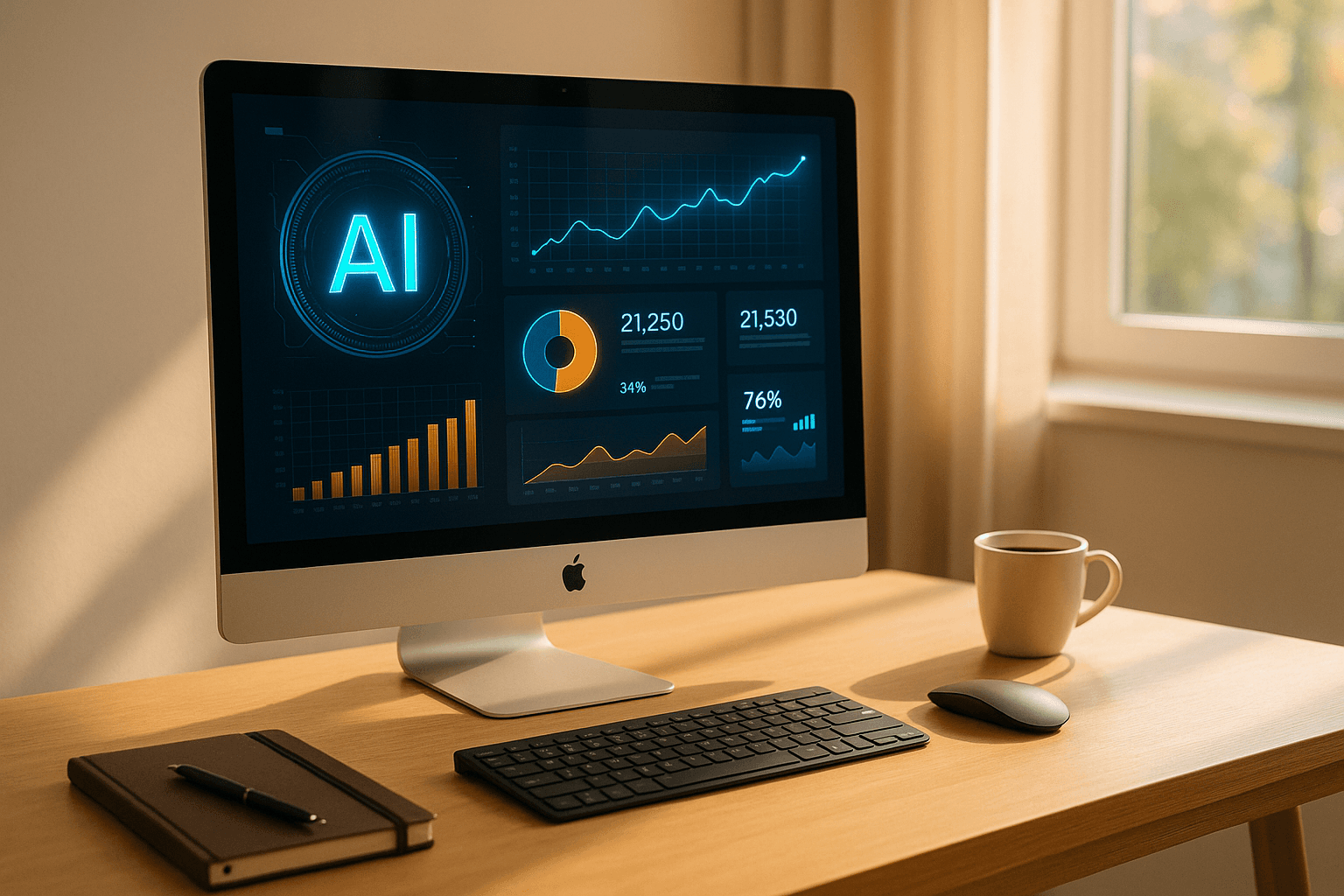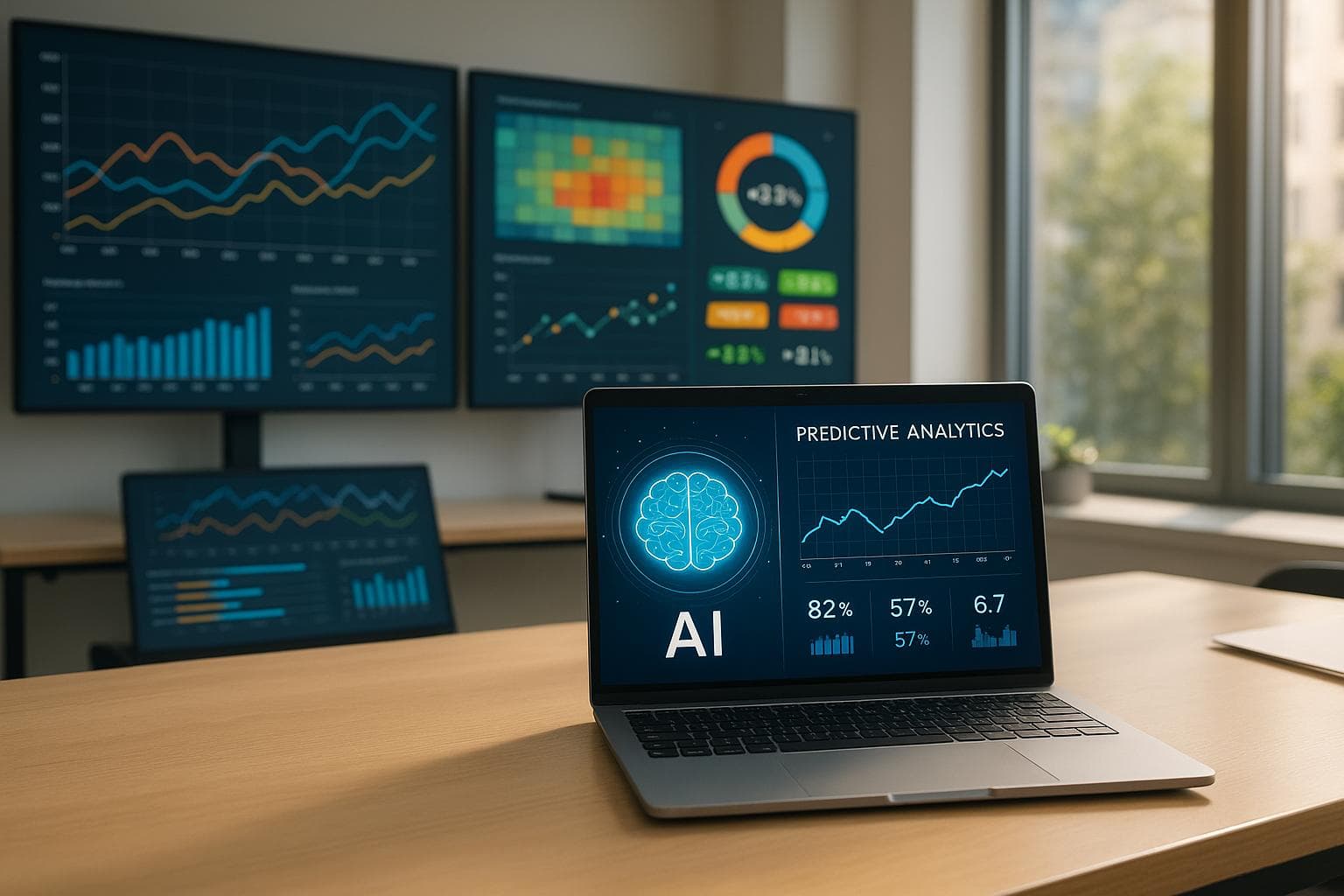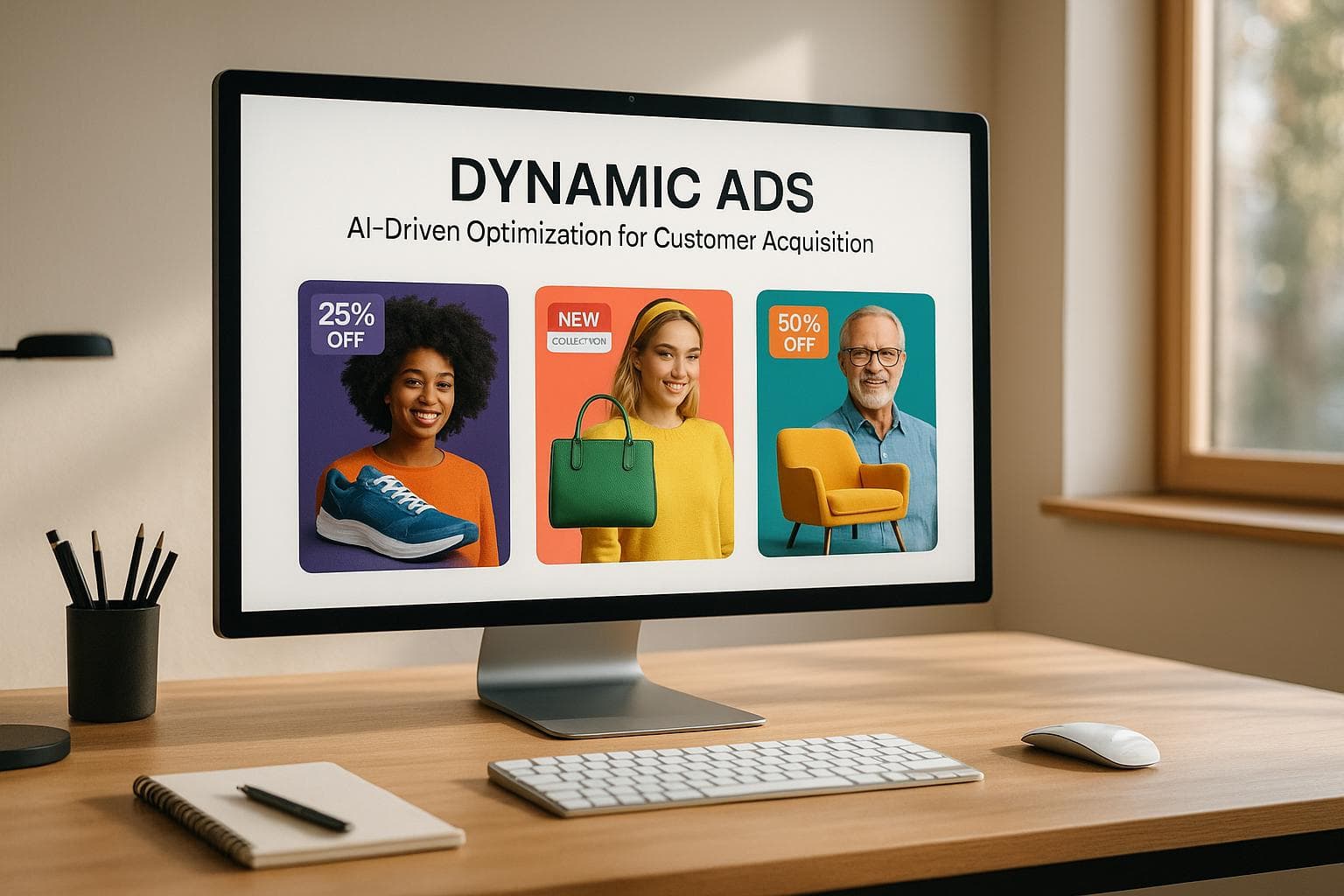AI in Incentive Campaigns: How It Works
Explore how AI transforms incentive campaigns through automation, personalization, and real-time optimization for better results.
AI is transforming how businesses run incentive campaigns, making them faster, smarter, and more personalized. By automating tasks like audience segmentation, offer customization, and campaign management, AI saves time and improves results. Platforms like Feedcast simplify this process, helping businesses create tailored campaigns across multiple channels, such as Google, Meta, and Microsoft Ads.
Here’s what you need to know:
- AI automates tasks like ad creation, audience targeting, and performance tracking.
- Personalization is key: AI analyzes customer behavior to craft offers that resonate with specific groups.
- Centralized management: Platforms provide unified dashboards to oversee campaigns on multiple channels.
- Time savings: Small businesses can save up to 85% of manual effort within three years.
- Real-time optimization: AI adjusts campaigns instantly based on performance data.
AI-powered tools like Feedcast also enhance product data, refine ad copy, and offer perks like Google Ads credits. Businesses using AI see better efficiency, higher sales, and reduced ad spend. To succeed, focus on clear goals, accurate product data, and compliance with privacy laws.
Automating Incentive Campaigns with AI
Setting Up Campaigns with AI
Platforms like Feedcast make campaign setup almost effortless by leveraging AI. They can sync product data directly from your e-commerce platform or data files, then refine titles, descriptions, and attributes to enhance ad performance. Essentially, your product descriptions are transformed into engaging, search-friendly content that connects with your audience.
Instead of manually creating ad copy for each platform, AI takes over and generates personalized content tailored for Google, Facebook, Instagram, and Microsoft Ads. This ensures that your messaging aligns with the unique audience preferences and behaviors of each platform, keeping it relevant and impactful across the board. Plus, AI maintains consistency in your campaigns while optimizing for maximum effectiveness.
Once your campaigns are set up, you can manage everything from a single, streamlined dashboard.
Managing Multiple Channels from One Place
AI brings all your campaigns together in one unified dashboard. Whether it’s Google Shopping, Facebook, or Instagram, you can monitor performance in real time and use data insights to adjust budgets, reallocating funds from underperforming channels to those delivering better results.
Having all your data centralized means you can easily pinpoint which channels are driving the most conversions and where your ad spend is working hardest. This not only simplifies the process but also provides a clear view of your overall campaign performance, saving time and reducing the complexity of managing multiple platforms.
This streamlined approach frees you up to focus on bigger-picture strategies, rather than getting bogged down in day-to-day monitoring.
Time Savings for Small Business Owners
AI automation can save small business owners a significant amount of time - up to 68% fewer manual hours in the first year and as much as 85% by year three [2]. For anyone juggling numerous responsibilities, this translates into dozens of extra hours each week that can be redirected to growing the business or planning long-term strategies.
Tasks like managing product feeds, creating ads, segmenting audiences, and tracking performance are handled seamlessly by AI systems that work 24/7. This constant optimization doesn’t just save time; it also drives better results. For example, AI-powered video reach campaigns have been shown to achieve 111% more incremental sales compared to manually optimized efforts [4].
AI also fine-tunes campaigns dynamically, adjusting ad timing, product selection, and messaging based on real-time performance data. This ensures your campaigns are always evolving and staying ahead of the curve - all without needing constant manual input.
Targeting and Personalization
AI-Driven Audience Segmentation
AI is changing the game for businesses by helping them pinpoint their most valuable customers through deep data analysis. By examining purchase history, browsing habits, demographics, and engagement metrics, machine learning algorithms uncover customer segments that traditional methods often overlook.
This approach goes far beyond simple factors like age or location. AI identifies micro-segments based on intricate behavior patterns. For instance, it can distinguish between people who browse athletic wear on weekends versus those who buy during the week or between those who prefer percentage-based discounts over fixed-dollar offers. These insights allow businesses to design highly specific incentives that greatly improve the chances of making a sale.
What makes AI even more powerful is its ability to adapt in real time. As customer behaviors change or new trends emerge, AI updates segment definitions automatically. This ensures that your targeting stays relevant and your campaigns continue to perform effectively. Such precise segmentation lays the groundwork for creating deeply personalized offers.
Personalizing Offers and Messaging
Feedcast leverages AI to craft customized ad copy and incentives for every customer segment across all your advertising platforms. By analyzing customer data alongside product details, the platform tailors messaging to resonate with specific groups - whether it's offering welcome deals to new customers or loyalty rewards to repeat buyers.
Take, for example, an online store specializing in athletic wear. AI might identify a group of customers who frequently shop for these items. The system could then generate ads promoting a limited-time discount on new arrivals in that category, using language and visuals designed to engage this particular audience. As the campaign runs, AI monitors engagement metrics in real time, fine-tuning both the offer and the messaging to maximize effectiveness.
This personalization goes beyond just tweaking discount rates. AI also adjusts tone, urgency, product suggestions, and even the timing of messages to align with each segment's preferences, resulting in ads that feel uniquely tailored and drive stronger engagement and conversions.
Using Better Product Data
Personalization isn’t just about messaging - it also relies on high-quality product data. Feedcast's AI enhances product information by optimizing titles, descriptions, and attributes, making ads more relevant and appealing to specific customer segments.
With enriched product data, AI can better match customer interests to the right products. When your product feeds include detailed and accurate information, AI can determine which items to promote to which segments more effectively. The system also identifies and fixes feed issues automatically while dynamically adjusting product listings based on performance metrics. This ensures that the most relevant products are shown to the right audience at the perfect moment.
| Campaign Element | AI-Optimized Approach | Traditional Approach |
|---|---|---|
| Audience Segmentation | Micro-segments based on behavior | Broad demographic groups |
| Message Personalization | Real-time dynamic content adjustments | Static messaging for large segments |
| Product Matching | AI-enriched data for precise targeting | Manual product categorization |
AI for Marketing: Automate Campaigns and Personalization at Scale
sbb-itb-0bd1697
Real-Time Optimization and Performance Analytics
Once automated and personalized incentive campaigns are in place, using real-time optimization and unified analytics can significantly enhance their impact.
Real-Time Campaign Adjustments
AI takes incentive campaigns to the next level by responding instantly to performance data. If performance starts to dip, AI can adjust pricing, tweak product placements, or refine messaging on the fly [1]. This ability to pivot quickly keeps campaigns effective, even as market conditions and consumer behaviors change or competitors introduce new strategies.
Another game-changer is AI-driven A/B testing. It automatically experiments with different messaging, creative elements, and timing, then implements the best-performing combinations in real time [1]. Companies leveraging AI in this way have reported noticeable improvements in conversion rates and customer engagement. This shift from static campaigns to a dynamic, experimental approach ensures campaigns stay relevant and impactful [1][2].
Unified Analytics Dashboard
To complement these real-time adjustments, Feedcast offers a centralized dashboard that provides a complete view of campaign performance. This platform consolidates data from all channels into one place, allowing users to monitor key metrics and make informed decisions without toggling between tools. Whether it’s reallocating budgets or updating creative assets, the dashboard enables quick, data-driven actions that maximize campaign results.
Custom reporting and performance segmentation add another layer of insight. Businesses can track trends, understand how specific customer segments respond to incentives, and address underperforming areas with precision. This not only improves efficiency but also reduces the need for manual intervention.
Measuring Success with Key Metrics
To gauge success, marketers rely on metrics like conversion rate, click-through rate (CTR), return on ad spend (ROAS), customer acquisition cost (CAC), and engagement indicators such as time on site or repeat purchase rate [1]. AI also tracks customer lifetime value (CLV) and analyzes performance across segments for deeper insights. By spotting trends, predicting outcomes, and recommending adjustments in real time, AI empowers marketers to continuously refine their strategies. Some reports suggest businesses using AI-driven platforms have seen ROI improvements of up to 30% [3].
Defining clear objectives and KPIs from the start is crucial. Whether the goal is immediate sales, long-term customer growth, or increased brand visibility, AI can tailor campaigns to meet those aims and provide actionable performance insights. Regularly reviewing real-time analytics, combined with AI-powered segmentation and ongoing testing, creates a feedback loop that keeps campaigns effective and adaptable over time.
Best Practices for AI-Powered Incentive Campaigns
Maximizing the potential of AI-powered incentive campaigns requires a thoughtful strategy that combines automation with careful human oversight. Establishing clear goals, maintaining compliance, and continuously optimizing campaigns are all key to success.
Launching AI-Powered Incentive Campaigns
Start by defining your objectives - whether it's boosting immediate sales, gaining new customers, or improving long-term retention. Allocate your monthly budget to ensure there's enough data for the AI to generate actionable insights. A robust budget helps the system learn and adjust effectively.
Make sure your product feeds are accurate and up-to-date. Include USD pricing, detailed descriptions, and high-quality images. Tools like Feedcast's AI-powered data enrichment can enhance product titles and descriptions, but starting with clean data gives your campaign a head start. Don’t forget to update seasonal or promotional details so the AI can make informed decisions.
When setting audience parameters, begin with broad demographic and interest categories. This approach allows the AI to identify high-performing segments over time, avoiding overly restrictive targeting that could limit its learning.
Test different types of incentives, such as percentage discounts, fixed-dollar savings, free shipping, or bundle offers. For instance, new customers might respond better to percentage discounts, while returning customers may appreciate free shipping for smaller purchases. Once campaigns are live, regular monitoring and adjustments become critical.
Monitoring and Improving Campaigns
In the first two weeks, keep a close eye on daily performance. While AI handles most optimizations, human oversight ensures that campaigns stay on track. Look out for unusual spending patterns, sudden performance changes, or technical glitches that may need manual intervention.
Use unified dashboards to track overall trends rather than getting caught up in daily fluctuations. Focus on identifying patterns, such as which products drive the most engagement or which incentives lead to the highest conversions.
Conduct weekly performance reviews to refine your strategy. This might involve reallocating budgets between high- and low-performing channels, adjusting product feeds, or analyzing customer segments. Even as the AI learns and improves, fresh and accurate data keeps your campaigns running smoothly.
Set automated alerts for critical metrics like cost per acquisition or conversion rates falling outside acceptable ranges. This proactive step helps you catch and address issues early. Many campaigns hit their stride after three to four weeks, once the AI has had time to adapt and optimize.
Finally, as you refine performance, make sure your campaigns remain compliant with evolving regulations.
Compliance and Cultural Considerations
Beyond performance, maintaining customer trust through compliance is crucial. In 2024, 61% of businesses using AI in marketing encountered compliance issues [5]. Regulatory penalties are no small matter - the FTC imposed over $785 million in fines for deceptive AI-generated advertising that year [5].
Data privacy laws in states like California, Connecticut, Colorado, Utah, and Virginia require businesses to handle customer data responsibly [6]. Ensure your AI respects user consent and preferences, as 43% of AI-driven marketing platforms fail to do so during personalization efforts [5].
Implement compliance measures early. This includes reviewing AI-generated content for legal risks, training AI on unbiased datasets, and avoiding the use of sensitive traits in ads [5]. Keep detailed logs of AI decisions and campaign logic to demonstrate accountability if needed.
Transparency is key. Research shows that 73% of consumers are more loyal to brands that clearly explain their use of AI [5]. Include disclosures about AI usage in your marketing materials and privacy policies. Update consent mechanisms to cover AI-powered personalization and offer easy opt-out options.
Automate compliance checks where possible. For example, set up systems to synchronize opt-out preferences across email, SMS, and other channels [5]. Businesses using AI-based compliance tools report significantly fewer privacy-related fines - 54% fewer, to be exact [5].
Regular audits are also essential. Review your AI systems, data practices, and privacy policies regularly. Strengthen data governance and ensure proper consent mechanisms are in place. Staying informed about regulatory changes will protect your business while keeping your AI campaigns effective.
"Technology is a useful servant but a dangerous master." - Christian Lous Lange [5]
Conclusion
AI is revolutionizing e-commerce campaigns, turning them from generic, one-size-fits-all promotions into highly tailored, dynamic experiences. This transformation isn’t just theoretical - it’s delivering real results, including up to a 30% boost in efficiency, 15–25% higher conversion rates, and a reduction in wasted ad spend by as much as 20% [7][1][2]. Feedcast.ai exemplifies this shift with its streamlined, AI-powered approach to campaign management.
FAQs
How does AI make incentive campaigns more personalized and effective?
AI is reshaping incentive campaigns by diving into individual behaviors, purchase histories, and engagement patterns to craft rewards that match each participant's specific preferences. By making incentives feel more personal and relevant, this approach boosts engagement and builds stronger loyalty.
Traditional methods often rely on one-size-fits-all rewards, but AI takes it a step further by adjusting in real-time based on participants' actions. This means rewards are tailored to genuinely motivate and encourage participation. The result? A better overall experience and improved campaign success, with higher satisfaction and participation rates.
What compliance factors should businesses consider when using AI in marketing campaigns?
When incorporating AI into marketing campaigns, businesses need to prioritize transparency, data privacy, and the responsible use of AI. Following federal and state regulations is essential, especially when it comes to avoiding discriminatory practices, ensuring precise targeting, and maintaining consumer trust.
To remain compliant, it's important to keep up with changing regulations surrounding AI-powered decision-making. Aligning campaigns with industry guidelines not only reinforces trust with your audience but also helps steer clear of legal and reputational issues.
How can small businesses save time using AI for incentive campaigns?
Small businesses can reclaim hours of their week by leveraging AI to handle repetitive tasks like creating ads, managing data, and tracking performance. These tools take over the manual work, allowing teams to focus on more impactful activities.
Another major advantage is AI's ability to optimize campaigns in real time. It can fine-tune targeting and adjust budgets automatically to enhance results with little to no input required. By simplifying these processes, businesses can shift their attention to strategic growth, achieving quicker and more efficient campaign results.
Geoffrey G.










